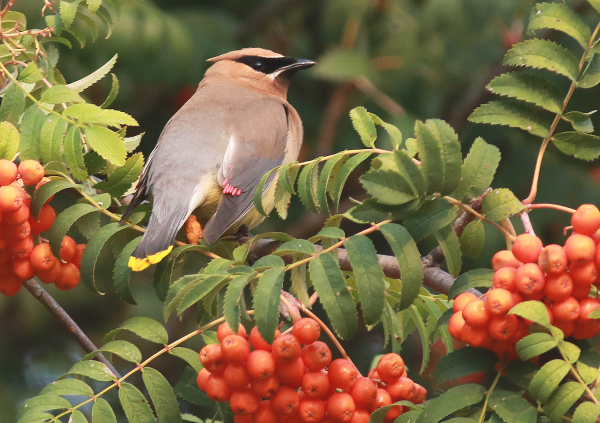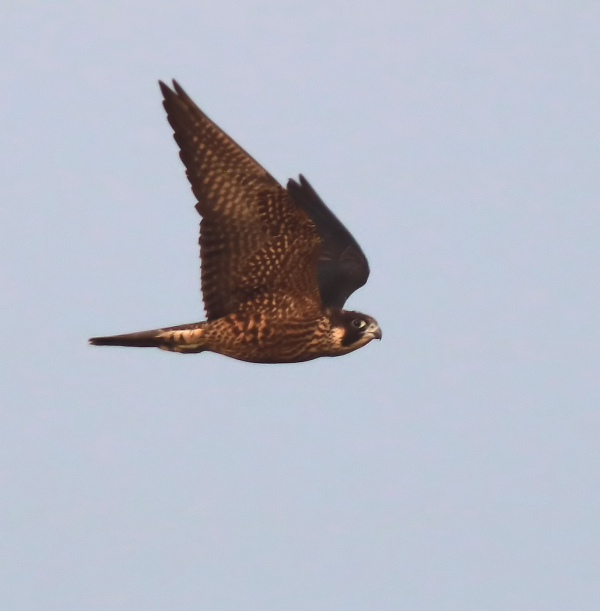
A Cedar Waxwing at rest after feeding on pyracantha berries, one waxwing of many in the tree.

Sighting, then photographing a young Peregrine with a dark-rufous underside was an especially adrenaline-pulsing experience late Monday afternoon.

When it stalks out of the cover of cattails and bulrushes along a edge of a marsh, an American Bittern always attracts the attention of birders, and often provides a statuary photo opportunity.
|
Standout sightings in the field included an adult Bald Eagle 8 miles south of my office late Monday afternoon, along with 2 first fall Cooper’s Hawks about 2 miles south. Tuesday afternoon’s drive yielded another Coop, an adult 4 miles south. Standout photo ops were mostly limited to wading birds throughout the week, including Great Egrets, an American Bittern, and Black-crowned Night Herons, including a yearling molting from first year plumage to adult plumage; although White-faced Ibis and Great Blue Herons were also in the area.
My late Saturday afternoon drive yielded lots of ducks, coots, and grebes, scattered Red-tailed Hawks, a couple American Kestrels near the eagle nest, but no eagles again and no Red-headed Woodpeckers in the area. There have obviously been more Northern Harriers in the area the past two weeks – adult gray males and brown females, along with first fall harriers that have an orange cast to their darker brown plumage. I was happy to see a big female Belted Kingfisher on the edge of a favorite lake, and took a couple distant photos. As I approached home, about ¾ of a mile to the south I appreciated a rare sighting of a Red-throated Grebe on glassy water that provided a couple documentary photos.
Saturday I only saw one Eastern Kingbird, and Western Kingbirds have been gone for weeks. Monday I didn’t see any kingbirds, but I did see 2 Say’s Phoebes – rare birds on this side of the Missouri River, and the first I’ve since spring migration. The passing of kingbirds and flycatchers is a seasonal change that coincides with cooler or colder temperatures and the resulting fewer small flying insects each September in Dakota country.
Peregrine!
The most exceptional sighting of the week took place Monday just 3 miles north of my office: I was thrilled see a Peregrine Falcon flying low and slow, apparently hunting along a little ridge near the road. I pulled over and the young tundra Peregrine circled to fly just north of me, headed east – allowing me to photograph it as it turned southeast. It’s always a thrill to have such an iconic falcon as this one in my camera frame, in focus in my telephoto lens, and this episode was special. Although the young Peregrine flew beyond photo range for a couple moments, it actually circled back to fly toward me, passing so close overhead that its wings did not fit within my photo frame – Wooee!
The first-fall Peregrine had notable rufous coloring on its ventral plumage, which is unique among the many Peregrines I’ve observed over the years. I watched as the falcon glided along a line of low trees, then focused on a Red-tailed Hawk that flew to one of the trees, with the falcon calling cack–cack a couple times it half-heartedly swooped low at the then-perched hawk. The Peregrine flew east again, this time much father northeast and out of sight. I considered trying to intercept it by driving a mile north, but before I opened the vehicle door I heard another call.
This time the young Peregrine was being chased and dived on by, would you believe it, another smaller Peregrine. Although the falcons were quite a distance away, I took a couple long-range photos to document the birds and a bit of the action, with the young falcon even rolling over onto its back to defend itself by presenting its talons toward the diving smaller male. The Peregrines parted after a couple dives, and I watched as each one faded into the sky in opposite directions – what fun!
McKenzie Shorebirds
Last Wednesday I checked the action east of Bismarck at McKenzie Slough, where I was surprised to see several hundred shorebirds assembled on the southwest side of the wetland. The water was little more than an inch deep in places, allowing Least, Pectoral, and Semipalmated Sandpipers to wade in the shallows in good numbers. A hundred feet farther north the water was another inch deeper with Stilt Sandpipers, Greater and Lesser Yellowlegs, and Long-billed Dowitchers feeding. And as the water became deeper a big flock of about 110 American Avocets was widely scattered as they fed, with the northern-most avocets swimming in deeper water as they foraged. There were probably more than 300 shorebirds total, with more than 130 ducks filter feeding farther to the west, primarily Blue-winged Teal, Northern Shovelers, and Mallards; along with a scattering of about a dozen White-faced Ibis.
Yard Excitement
A continued trickle of migrating songbirds passed through my yard last week, including a Tennessee Warbler Tuesday, and another Wednesday. Gray Catbirds fed on grape jelly and drink at my water basin daily, including 2 at the same time Thursday. Tuesday and Wednesday a sneaky Blue Jay visited my feeding station without even a murmur of one call, suggesting it was a new bird in the area; and a couple very loud Blue Jays returned to my suet feeder Saturday. My nectar feeder action was limited to 2 Ruby-throated Hummingbirds through the week, but they continue to provide a special addition with each visit.
During a pleasant work afternoon Saturday, feeder action was punctuated by at least 3 visits each by a young female Hairy Woodpecker and the first adult male I’ve seen in months. They continue to visit my suet feeder, although Blue Jays have been absent since Saturday. Sunday the first Downy Woodpecker since spring visited my suet feeder, a male; and later, 2 female or young Purple Finches stopped by – very early northern finches!
Thursday I was excited to see 7 Cedar Waxwings foraging on insects in the tops of some nearby cottonwood trees. I noticed them again Friday afternoon, probably more than 7, with a Red-eyed Vireo in their midst. That made me do a little recognizance in the area and I noticed waxwings headed for a pyracantha tree laden with clusters of small orange berries that was bustling with a flock of robins in the bottom half and several waxwings feeding in the top third.
I expected that tree would be a target of these birds in coming days, so I awaited the sun Saturday afternoon to try some photos. Indeed, as predicted the sky cleared for ample sunshine mid-afternoon Saturday, and I photographed an adult Cedar Waxwing with two young feeding on the berries, and later I saw that several feeding robins dominated the treetop. Monday afternoon, there must have been about 20 waxwings feeding in the same tree, most of them young of the year, plus there were another dozen robins foraging, making the tree the center of attention in the area.
Enjoy the upcoming week of September, one of my favorites of the year. During the week we will slip from the calendar version of summer into the official start of the fall season on Tuesday September 22nd. Here in Dakota, it’s been fall since the last couple days of August, but this week we’ll make it official and celebrate all the birds and birding opportunities of fall.
Article and photos by Paul Konrad
Share your bird sightings and photos at editorstbw2@gmail.com